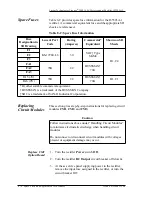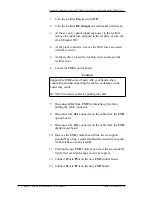
Lucent Technologies Lineage
®
2000 100A Ferroresonant Rectifier J85503A-1
8 - 18 Spare Parts and Replacement Procedures
Issue 6 October 1998
2. The diode is now electrically isolated for test purposes.
3. If this procedure is being performed to test a diode, skip to
Step 8. To replace a diode that is known to be defective,
continue with Step 4.
4. Refer to the next section to remove any heat shrink tubing
and tape on the pigtail connection.
5. With the actual connection exposed, remove the nut and
bolt that holds the connection together. Save the hardware
for reinstallation. Discard the defective diode.
6. Connect the pigtail lead of the replacement diode by
reversing the work done in the previous two steps, Step 5
first and then Step 4. Use the hardware saved in Step 5.
When reversing Step 4, use heavy duty (thick wall) heat
shrink tubing rated at 300 volts minimum at 105 degrees
Celsius. See the next section for a recommended type of
heat shrink tubing. If electrical tape is used, it should be
identically rated.
7. Install the stud of the replacement diode through the
mounting hole in the heat sink. Use the thermal pad,
DP125, comcode 405229154 that was saved in Step 2.
Install the new stud nut and torque to 100-125 in-lbs. This
completes the rectifier diode replacement procedure. If
maintenance is completed, reinstall the diode heat sink
assembly as described above under “Diode Heat Sink
Assembly”.
8. Testing a Rectifier Diode: Use a meter with a diode test
function, or measure the forward and backward resistances
of the diode, to determine if the diode is good. A good
diode should measure at least 50 ohms in both directions,
and one direction should measure at least 50 times the
other. The larger resistance is, of course, the back
resistance, and the smaller is the forward resistance.
Most diodes that fail do so by shorting (i.e. they measure
shorted or almost shorted in both directions). The pigtail
side of the diode can be electrically accessed, with a clip
lead or probe, by pushing the insulating tubing and/or tape
approximately 1/4 to 1/2-inch away from the point where
the pigtail lead enters the diode body.







































